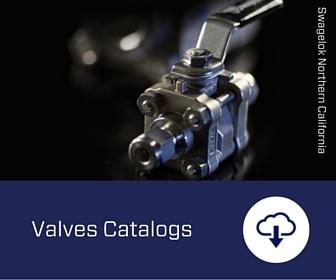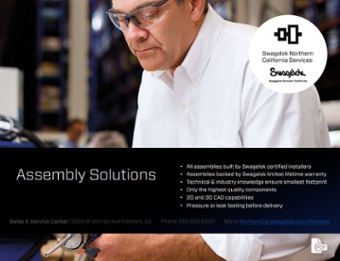Share this
Which Valve Is Right For Your Fluid System? Let Us Show You
by Jeff Hopkins on 4/20/17 8:30 AM
Don't let yourself get overwhelmed by the wide variety of styles and sizes
Swagelok's selection of valves can seem overwhelming at first. There are ball valves, diaphragm and bellows valves, as well as check valves, excess flow valves, fine metering, multi-port, needle, plug, relief, rising plug, and safety valves.
Each type comes in many sizes, configurations, materials of construction, and actuation modes.
So let's break it down into some more manageable chunks of information.
First, there are the kinds of valves used for the most basic on-off functions. That list includes ball valves, diaphragm valves and bellows valves. The right choice depends on how large your line is, how quickly you need to start or stop flow, how "clean" your system is, whether you need a good seal to the atmosphere, among other factors.
More control
Sometimes you want to do more than just turn the flow on or off. Let's say you want to set the handle for a particular rate of flow and have it stay there. The most common choices are needle valves, fine metering valves and plug valves. For the most precise control, choose a type of needle valve called a fine-metering valve. Be aware that some models are not designed to shut off.
Then there are quarter-turn plug valves, commonly used for low-pressure throttling applications. A closely related design is the rising plug valve. They aren't as effective at providing fine gradations of flow, but they are roddable, which makes them a good choice if the valve gets clogged.
If you need to control the direction of fluid flow, you'll probably want a check valve. When downstream pressure rises, the valve closes on its own. Some check valves are adjustable to a specific pressure. Flow can also be directionally controlled with some ball valves and diaphragm valves that have multiple ports for outflow.
While valves don't regulate pressure, some types do prevent the buildup of system pressure beyond a certain point. One type is the relief valve, with a vent that opens to the atmosphere when the system pressure exceeds a point that you've selected. A variation on the design is the safety relief valve, designed to open quickly and release large amounts of fluid.
Rupture discs also vent to the atmosphere. They are used mainly on sample cylinders to guard against over-pressurization, such as when temperature rises. Once the disc bursts, it must be replaced.
Then there are excess flow valves to stop uncontrolled release of fluids if the line ruptures downstream.
Know your system
Beyond that, there are a few common-sense pieces of information to have ready when you make your selection. First, know the chemical composition of the system media and the full range of pressure and temperatures that the valve will have to deal with. Make sure your valve is made of the right materials for your application.
Whenever you add a valve or other component to your system, it usually produces a drop in pressure. You need to be aware of the cumulative pressure drop.
Lastly, the true cost of a valve is the purchase price plus the cost of owning, maintaining and replacing that valve over time. Note that some valves are much easier to service than others. Some can be serviced in place; others must be removed from the process line. Different valves have different maintenance schedules, an obvious point that is often overlooked. Are you willing to service that valve once every 20 days when it is 100 feet in the air?
Great resources
Now that you know the basics, you are ready to move on to some details. Get off to a good start by downloading three essential resources:
- Matching Valve Type to Function: A Tutorial in Valve Selection. This four-page PDF covers on-off valves, directional flow valves, flow-control valves, overpressure protection valves, excess flow valves, and a selection guideline summary.
- Valve Sizing Technical Bulletin. An 11-page PDF that shows how flow can be estimated well enough to select a valve size—easily, and without complicated calculations.
- Valve Selection Worksheet. Our two-page PDF covers valve function, system conditions, flow, and many other factors such as actuation method, lock-out / tag-out, position indicator, materials of construction, and more.
Additional Resources
Share this
- Archive (465)
- Assembly Services (207)
- About (100)
- Seal Support Systems (96)
- Best Practices (88)
- Training Services (74)
- Fittings (51)
- Semiconductor Applications (49)
- Hoses and Flexible Tubing (47)
- Regulators (44)
- Tubing (42)
- Grab Sampling Systems (32)
- Sampling Systems (32)
- Gas Systems (30)
- Services (30)
- Downloads (29)
- Valves (24)
- Application Support (18)
- Orbital Welding (17)
- Case Studies (13)
- Steam Systems (13)
- Frequently Asked Questions (12)
- Tools (12)
- Measurement Devices (7)
- Subsystems (6)
- Thermal Management (6)
- September 2023 (1)
- August 2023 (2)
- June 2023 (1)
- March 2023 (3)
- February 2023 (3)
- January 2023 (4)
- December 2022 (4)
- November 2022 (4)
- October 2022 (4)
- September 2022 (1)
- August 2022 (3)
- July 2022 (2)
- June 2022 (4)
- May 2022 (1)
- April 2022 (2)
- March 2022 (1)
- February 2022 (2)
- January 2022 (3)
- December 2021 (1)
- November 2021 (6)
- October 2021 (6)
- September 2021 (8)
- August 2021 (4)
- July 2021 (3)
- June 2021 (6)
- May 2021 (6)
- April 2021 (7)
- March 2021 (5)
- February 2021 (4)
- January 2021 (6)
- December 2020 (5)
- November 2020 (6)
- October 2020 (6)
- September 2020 (8)
- August 2020 (7)
- July 2020 (8)
- June 2020 (8)
- May 2020 (6)
- April 2020 (9)
- March 2020 (7)
- February 2020 (10)
- January 2020 (21)
- December 2019 (23)
- November 2019 (21)
- October 2019 (22)
- September 2019 (21)
- August 2019 (22)
- July 2019 (23)
- June 2019 (20)
- May 2019 (23)
- April 2019 (22)
- March 2019 (21)
- February 2019 (20)
- January 2019 (21)
- December 2018 (14)
- November 2018 (19)
- October 2018 (23)
- September 2018 (17)
- August 2018 (29)
- July 2018 (11)
- June 2018 (6)
- May 2018 (5)
- April 2018 (4)
- March 2018 (5)
- February 2018 (3)
- January 2018 (3)
- December 2017 (2)
- November 2017 (4)
- October 2017 (3)
- September 2017 (2)
- August 2017 (6)
- July 2017 (4)
- June 2017 (4)
- May 2017 (4)
- April 2017 (3)
- March 2017 (4)
- February 2017 (3)
- January 2017 (3)
- December 2016 (3)
- November 2016 (3)
- October 2016 (3)
- September 2016 (5)
- August 2016 (5)
- July 2016 (4)
- June 2016 (5)
- May 2016 (3)
- April 2016 (4)
- March 2016 (5)
- February 2016 (11)
- January 2016 (1)
- December 2015 (3)
- November 2015 (4)
- October 2015 (3)
- September 2015 (4)
- August 2015 (4)
- July 2015 (8)
- June 2015 (5)
- May 2015 (3)
- April 2015 (4)
- March 2015 (4)
- February 2015 (3)
- January 2015 (4)
- December 2014 (2)
- November 2014 (3)
- October 2014 (4)
- September 2014 (4)
- August 2014 (4)
- July 2014 (5)
- June 2014 (4)
- May 2014 (4)
- April 2014 (5)
- March 2014 (4)
- February 2014 (3)
- January 2014 (4)
- December 2013 (5)
- November 2013 (3)
- October 2013 (4)
- September 2013 (3)
- August 2013 (5)
- July 2013 (5)
- June 2013 (5)
- May 2013 (3)
- April 2013 (6)
- March 2013 (4)
- February 2013 (4)
- January 2013 (8)
- December 2012 (4)
- November 2012 (6)
- October 2012 (6)
- September 2012 (4)
- August 2012 (4)
- July 2012 (4)
- June 2012 (4)

.webp?width=210&height=70&name=StickyLogo%20(5).webp)


